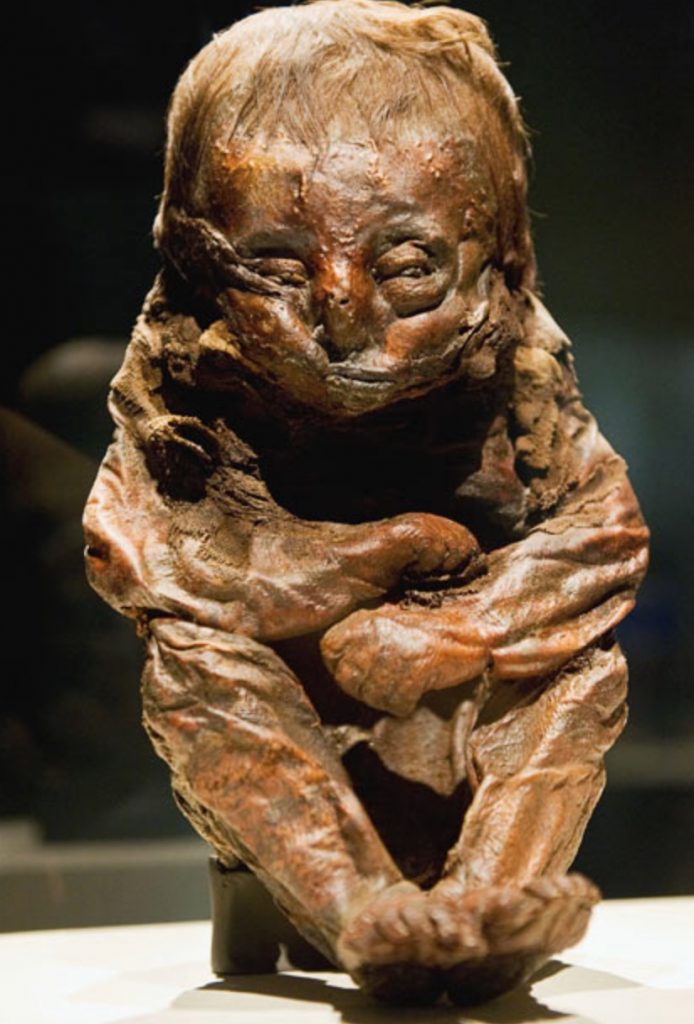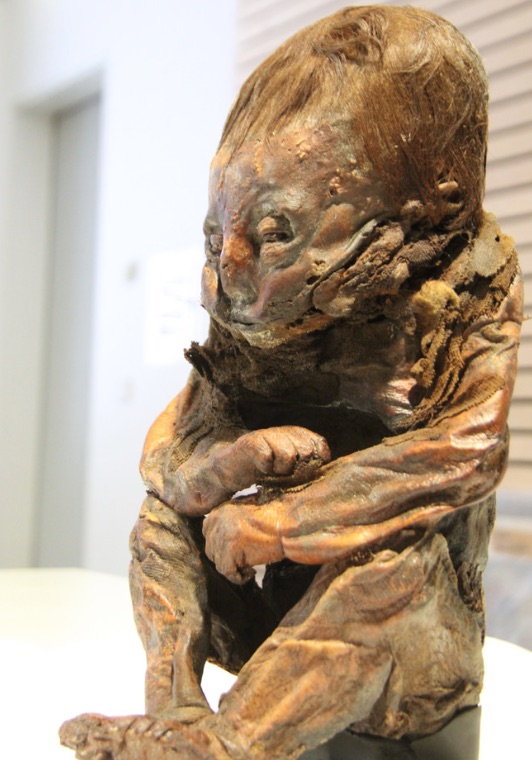A Child in a Jar, Thoughts on Mummies of the World


The Detmold Child (Mummies of the World)
As I inspected the mummified remains of a small child, I thought of my own small ones who scamper about making noise and wreaking havoc. The care with which the child had been placed, with wrappings, small tokens and gifts, was also evident. I felt that I was standing in someone’s sacred place.
The exhibit, Mummies of the World that came to Salt Lake City, Utah relied heavily on Peruvian mummies. The collection came from Mannheim Germany, from the Reiss-Engelhorn Museum. The bodies had been collected over years through expeditions throughout the world. Some mummies were purchased and some donated and some were even ‘discovered’ in the basement of the Reiss Engelhorn museum. The mummies were believed ‘lost’ until someone stumbled across them while going through the museums many rooms.
The exhibit caused conflict within my soul. While it provided the public the opportunity to learn of the ancient cultures I could not help but echo the sentiments of, Dietrich Wildung, director of the Egyptian Museum in Berlin when he said that the exhibition could be described as “mummy pornography”. His feeling, echoed by others, was that human burials should be considered sacrosanct.

One of the truly rare mummies is that of an 8 to 10 month old child. It is haunting because it is easy to see the care with which the baby was buried, the skin remains intact and the shape of the plump cheeks is also preserved. There is a small amulet around the baby’s neck. The child is so well preserved, it has been determined that the child had a heart defect, correctable in modern society. The same modern society that subjected the child to x-rays, ultra sound tests and other interventions to determine age, diagnose not only the heart defect, but the pneumonia that probably led to the child’s death, and to bring up a controversy amongst scientists about baby’s head shape.

There are two arguments about the shape of the skulls of people found in ancient burials in the Andes. One is that the culture of the Andes found elongated skulls to be beautiful, so heads of infants were often wrapped to cause the skull to grow in the fashionable style. The shape reflected membership in a group as well as style and perhaps social hierarchy.
The second may be a question of a vitamin D deficiency, causing a dysfunction known as oxycephaly that causes the premature fusing of the sutures resulting in a similar shaping of the skull. This has been a posited theory for over 150 years, with Rivero and Tschudi discussing finding a fetus within a pregnant mummy whose child had an elongated skull. They argued that the deformation may have been natural.
The two arguments have raged from the late 19th century. Some believe the deformation is artificially applied to echo the shape of a member of society who had gained status and who was possessing of the crowning head, artificial means were employed, wrapping the skulls of infants to create the same effect. It has even been suggested that the people unearthed near Lake Titicaca “belonged to a race of mankind now extinct, and which differed from any now existing”, although this idea has been rejected by current science.
The question of elongated skulls still remains, and many tests have been performed on the child that may have lived over 5,000 years ago.
The child, like so many of the preserved remains showed great care in burial and a hope for life after death. Care was given to leave tokens, offerings, and gifts to/for the dead. While it was interesting and educational to view these bodies and reflect about such things as their last meal or the fact that they had suffered bouts of malnutrition, or even that they perhaps represented a different race of mankind, did that end justify their removal from their burials?
This quandary of ethics was troubling and enlightening. There were no signed documents, either by those on display or by the next of kin saying that the bodies could be used in such ways. Yet, there was also so much to be learned about culture, about history, about biology from these silent speakers.
References
http://www.dw.com/en/the-lost-mummies-of-mannheim-meet-the-public/a-2799960
Rivero and Tschudi (1852) Antigüedades peruanas(Peruvian Antiquities), issue 1851/1852
Graves, R.J. (1834). “Remarkable skulls found in Peru”. The Dublin Journal of Medical and Chemical Science
http://www.abovetopsecret.com/forum/thread1039390/pg1
https://web.archive.org/web/20130716015522/
http://www.katu.com:80/sponsored/mummies-of-the-world/Mummy-fact-sheet-210135051.html




